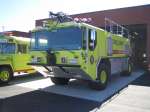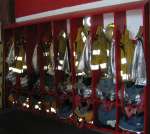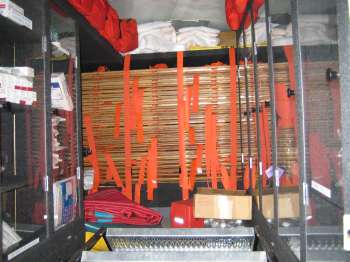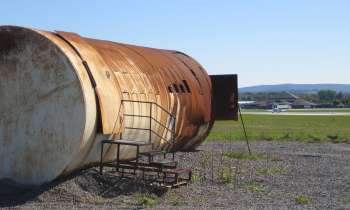- By Dan Veaner
- News
 Print
Print
On Wednesday night (9/28) victims of air disasters were rescued from planes at the Tompkins-Ithaca airport in Lansing. At least seven fire departments responded, as well as several ambulance services. All units were coordinated by the Airport Fire Department, a ten man department whose jurisdiction extends to the airport and planes that land there.
This was all part of a disaster drill. The FAA mandates that airport fire departments conduct a full scale drill every three years. Volunteers play the role of victims, while the responders test their readiness, coordination and ability to rescue passengers in a disaster.
The Airport Fire Department holds drills every year. Two of the three years they hold "table top" drills in which fire chiefs and responders go through procedures on paper and using overhead projections. "Every three years we have to do a full scale drill like this one," says Airport Fire Chief Dave Crawford. "We get volunteer victims, and everybody responds."
In 1970 the FAA mandated that all airports with commercial airlines are required to maintain a fire department. The Tompkins-Ithaca department has three trucks and a staff of ten. They also have the only mobile mass casualty vehicle in the county, a bus that is equipped with 50 back boards, medical supplies and equipment.
----
v1i11
This was all part of a disaster drill. The FAA mandates that airport fire departments conduct a full scale drill every three years. Volunteers play the role of victims, while the responders test their readiness, coordination and ability to rescue passengers in a disaster.
 The Airport Fire Department has three fire trucks and a mobile mass casualty vehicle with enough equipment and supplies to help 50 victims |  Regular suits and silver heat reflecting suits are ready when needed |
The Airport Fire Department holds drills every year. Two of the three years they hold "table top" drills in which fire chiefs and responders go through procedures on paper and using overhead projections. "Every three years we have to do a full scale drill like this one," says Airport Fire Chief Dave Crawford. "We get volunteer victims, and everybody responds."
In 1970 the FAA mandated that all airports with commercial airlines are required to maintain a fire department. The Tompkins-Ithaca department has three trucks and a staff of ten. They also have the only mobile mass casualty vehicle in the county, a bus that is equipped with 50 back boards, medical supplies and equipment.
 The back of the mobile mass casualty vehicle has 50 backboards and cabinets full of supplies in the back of the bus. The front is outfitted as a command center. |
All ten are EMTs. They train year round on aircraft systems and components so they will be prepared for an air crash if it comes. Their jurisdiction is for aircraft and the airport area. The unit is entirely paid for by airport revenue, including rent from airport tenants and landing fees, not with County tax dollars. The Federal government pays for the fire trucks. The department is open while the airlines are flying, from about 5am to midnight. The rest of the time they are on call. "We do respond to medical and structural calls in the airport," says Mr. Crawford.
They also supplement the Lansing and Cayuga Heights fire departments. "Lansing uses us quite a bit," says Chief Crawford. "If they get a car wreck out here on Route 13, if they need multiple EMTs. Occasionally they need us to come out with our jaws to help with a car wreck. We try to reciprocate for the help they give us as much as we can."
The disaster drill involves many area fire departments including Lansing, Cayuga Heights, Varna, Etna, Dryden, and Ithaca. Bangs ambulance has priority in the drill because it is their jurisdiction. Groton, Dryden, Slaterville, Trumansburg ambulances are also part of the drill. The airport firemen rely on local fire departments to help when the worst happens, because a fifty-passenger disaster would be too much for one fire department to handle on its own.
Each drill has surprises for the responders, because real disasters are unpredictable. "The first zinger we have is that this is the first night drill we have done in a long time," says Mr. Crawford. "That's a challenge all in itself. We didn't throw many more zingers in this year. The drills have all gone well."
They set up mass casualty triage and transport sectors. EMS is a big segment of what is being evaluated in this year's drill. "We try to focus on a couple of areas each year," says Chief Crawford. Firemen practice everything from fire attack to extrication. Once extrication is done they go to the EMS sector to help out.
Prior to 2001 the biggest aircraft that flew into the airport could hold about 150 to 170 people. Now the biggest aircraft holds 53 people. Chief Crawford says he's been trying to get an old aircraft to practice on for years, but he hasn't been able to. Instead the department uses aircraft simulators at the Airport Fire Department's training site on Snyder Road. These resemble parts of aircraft so that responders can get the feel of rescuing people if the worst were to happen. We built a simulator this year that resembles an aircraft that has actual "cut in" sections."
 Aircraft simulators used for training are situated across the field from the terminal. They were instrumental in the emergency drill |
"The other one we actually use for "full burn" simulations, but, obviously, not when we have people in there. We train on it. It's made out of very heavy gauge metal." The Airport department practices on it during the year along with Lansing, Cayuga Heights and Varna fire fighters.
Since the airport was in use the drill couldn't take place in operational areas. Responders came to the normal staging areas to get their assignments, then were sent to the training site.
"Aviation is the safest form of travel. We're mandated to be here, but we don't get to do our job. We get about 40 calls a year, but that includes the EMS calls mutual aid calls. Little planes, stuff you don't hear about in the news, they'll land with the gear up or go off in the bushes someplace... If we got a lot more calls like that, if planes were crashing every day, we'd be out of a job because no one would want to fly! We say 'We're the guys in the silver suits that you never want to see.'"
But if you did need to see them they would be most welcome. And because of regular emergency drills they'd know exactly what they'd need to do to save you.
----
v1i11



